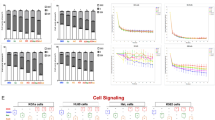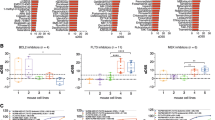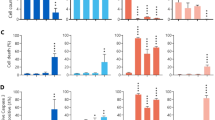Summary
Effective inhibition of BCR-ABL tyrosine kinase activity with Imatinib represents a breakthrough in the treatment of patients with chronic myeloid leukemia (CML). However, more than 30 % of patients with CML in chronic phase do not respond adequately to Imatinib and the drug seems not to affect the quiescent pool of BCR-ABL positive leukemic stem and progenitor cells. Therefore, despite encouraging clinical results, Imatinib can still not be considered a curative treatment option in CML. We recently reported downregulation of eukaryotic initiation factor 5A (eIF5A) in Imatinib treated K562 cells. Furthermore, the inhibition of eIF5A by siRNA in combination with Imatinib has been shown to exert synergistic cytotoxic effects on BCR-ABL positive cell lines. Based on the structure of known deoxyhypusine synthase (DHS) inhibitors such as CNI-1493, a drug design approach was applied to develop potential compounds targeting DHS. Here we report the biological evaluation of selected novel (DHSI-15) as compared to established (CNI-1493, deoxyspergualin) DHS inhibitors. We show that upon the compounds tested, DHSI-15 and deoxyspergualin exert strongest antiproliferative effects on BCR-ABL cells including Imatinib resistant mutants. However, this effect did not seem to be restricted to BCR-ABL positive cell lines or primary cells. Both compounds are able to induce apoptosis/necrosis during long term incubation of BCR-ABL positive BA/F3 derivates. Pharmacological synergism can be observed for deoxyspergualin and Imatinib, but not for DHSI-15 and Imatinib. Finally we show that deoxyspergualin is able to inhibit proliferation of CD34+ progenitor cells from CML patients. We conclude that inhibition of deoxyhypusine synthase (DHS) can be supportive for the anti-proliferative treatment of leukemia and merits further investigation including other cancers.





Similar content being viewed by others
References
Champlin RE, Golde DW (1985) Chronic myelogenous leukemia: recent advances. Blood 65(5):1039–1047
Lobo NA et al (2007) The biology of cancer stem cells. Annu Rev Cell Dev Biol 23:675–699
Sattler M, Griffin JD (2003) Molecular mechanisms of transformation by the BCR-ABL oncogene. Semin Hematol 40(2 Suppl 2):4–10
Sawyers CL et al (2002) Imatinib induces hematologic and cytogenetic responses in patients with chronic myelogenous leukemia in myeloid blast crisis: results of a phase II study. Blood 99(10):3530–3539
Talpaz M et al (2002) Imatinib induces durable hematologic and cytogenetic responses in patients with accelerated phase chronic myeloid leukemia: results of a phase 2 study. Blood 99(6):1928–1937
O’Brien SG et al (2003) Imatinib compared with interferon and low-dose cytarabine for newly diagnosed chronic-phase chronic myeloid leukemia. N Engl J Med 348(11):994–1004
Capdeville R et al (2002) Glivec (STI571, imatinib), a rationally developed, targeted anticancer drug. Nat Rev Drug Discov 1(7):493–502
Deininger M, Buchdunger E, Druker BJ (2005) The development of imatinib as a therapeutic agent for chronic myeloid leukemia. Blood 105(7):2640–2653
O’Hare T, Corbin AS, Druker BJ (2006) Targeted CML therapy: controlling drug resistance, seeking cure. Curr Opin Genet Dev 16(1):92–99
Balabanov S et al (2007) Hypusination of eukaryotic initiation factor 5A (eIF5A): a novel therapeutic target in BCR-ABL-positive leukemias identified by a proteomics approach. Blood 109(4):1701–1711
Park MH, Cooper HL, Folk JE (1982) The biosynthesis of protein-bound hypusine (N epsilon -(4-amino-2-hydroxybutyl)lysine). lysine as the amino acid precursor and the intermediate role of deoxyhypusine (N epsilon -(4-aminobutyl)lysine). J Biol Chem 257(12):7217–7222
Gordon ED et al (1987) Eukaryotic initiation factor 4D, the hypusine-containing protein, is conserved among eukaryotes. J Biol Chem 262(34):16585–16589
Bartig D et al (1992) The archaebacterial hypusine-containing protein. Structural features suggest common ancestry with eukaryotic translation initiation factor 5A. Eur J Biochem 204(2):751–758
Li CH et al. eIF5A promotes translation elongation, polysome disassembly and stress granule assembly. PLoS One 5(4):e9942.
Kruse M et al (2000) Inhibition of CD83 cell surface expression during dendritic cell maturation by interference with nuclear export of CD83 mRNA. J Exp Med 191(9):1581–1590
Maier B et al. The unique hypusine modification of eIF5A promotes islet beta cell inflammation and dysfunction in mice. J Clin Invest 120(6): 2156–70.
Hart RA et al (2002) Effects of 1,8-diaminooctane on the FIV Rev regulatory system. Virology 304(1):97–104
Katahira J et al (1995) Effects of translation initiation factor eIF-5A on the functioning of human T-cell leukemia virus type I Rex and human immunodeficiency virus Rev inhibited trans dominantly by a Rex mutant deficient in RNA binding. J Virol 69(5):3125–3133
Sommer MN et al (2004) Screening assay for the identification of deoxyhypusine synthase inhibitors. J Biomol Screen 9(5):434–438
Hauber I et al (2005) Identification of cellular deoxyhypusine synthase as a novel target for antiretroviral therapy. J Clin Invest 115(1):76–85
Nishimura K et al (2002) Inhibition of cell growth through inactivation of eukaryotic translation initiation factor 5A (eIF5A) by deoxyspergualin. Biochem J 363(Pt 3):761–768
Bianchi M et al (1995) An inhibitor of macrophage arginine transport and nitric oxide production (CNI-1493) prevents acute inflammation and endotoxin lethality. Mol Med 1(3):254–266
Ulrich P, Cerami A (1984) Trypanocidal 1,3-arylene diketone bis(guanylhydrazone)s. Structure-activity relationships among substituted and heterocyclic analogues. J Med Chem 27(1):35–40
Balabanov S et al. Abcg2 overexpression represents a novel mechanism for acquired resistance to the multi-kinase inhibitor Danusertib in BCR-ABL-positive cells in vitro. PLoS One 6(4): e19164.
Bartolovic K et al (2004) Inhibitory effect of imatinib on normal progenitor cells in vitro. Blood 103(2):523–529
Gontarewicz A et al (2008) Simultaneous targeting of aurora kinases and Bcr-Abl kinase by the small molecule inhibitor PHA-739358 is effective against imatinib-resistant BCR-ABL mutations including T315I. Blood 111(8):4355–4364
Hartmann U et al (2005) Telomere length and telomerase activity in the BCR-ABL-transformed murine Pro-B cell line BaF3 is unaffected by treatment with imatinib. Exp Hematol 33(5):542–549
Park MH, Wolff EC, Folk JE (1993) Is hypusine essential for eukaryotic cell proliferation? Trends Biochem Sci 18(12):475–479
Clement PM et al (2003) Identification and characterization of eukaryotic initiation factor 5A-2. Eur J Biochem 270(21):4254–4263
Clement PM et al (2006) Differential expression of eIF5A-1 and eIF5A-2 in human cancer cells. FEBS J 273(6):1102–1114
Nishimura K et al (2005) Independent roles of eIF5A and polyamines in cell proliferation. Biochem J 385(Pt 3):779–785
Li AL et al (2004) A novel eIF5A complex functions as a regulator of p53 and p53-dependent apoptosis. J Biol Chem 279(47):49251–49258
Capdeville R et al (2008) Report of an international expanded access program of imatinib in adults with Philadelphia chromosome positive leukemias. Ann Oncol 19(7):1320–1326
Hochhaus A et al (2009) Six-year follow-up of patients receiving imatinib for the first-line treatment of chronic myeloid leukemia. Leukemia 23(6):1054–1061
Branford S, Hughes T (2006) Detection of BCR-ABL mutations and resistance to imatinib mesylate. Methods Mol Med 125:93–106
Zonder JA, Schiffer CA (2006) Update on practical aspects of the treatment of chronic myeloid leukemia with imatinib mesylate. Curr Hematol Malig Rep 1(3):141–151
O’Hare T et al. Targeting the BCR-ABL signaling pathway in therapy-resistant Philadelphia chromosome-positive leukemia. Clin Cancer Res 17(2): 212–21.
Iwasawa H et al (1982) Synthesis of (−)-15-deoxyspergualin and (−)-spergualin-15-phosphate. J Antibiot (Tokyo) 35(12):1665–1669
Valdivia LA et al (1991) Suppressor cells induced by donor-specific transfusion and deoxyspergualin in rat cardiac xenografts. Transplantation 52(4):594–599
Hommes D et al (2002) Inhibition of stress-activated MAP kinases induces clinical improvement in moderate to severe Crohn’s disease. Gastroenterology 122(1):7–14
Sun Z et al. Apoptosis induction by eIF5A1 involves activation of the intrinsic mitochondrial pathway. J Cell Physiol 223(3): 798–809.
Saglio G et al. Nilotinib versus imatinib for newly diagnosed chronic myeloid leukemia. N Engl J Med 362(24): 2251–9.
Kantarjian H et al. Dasatinib versus imatinib in newly diagnosed chronic-phase chronic myeloid leukemia. N Engl J Med 362(24): 2260–70.
Cortes JE et al. Safety and efficacy of bosutinib (SKI-606) in chronic phase Philadelphia chromosome-positive chronic myeloid leukemia patients with resistance or intolerance to imatinib. Blood 118(17): 4567–76.
O’Hare T et al (2009) AP24534, a pan-BCR-ABL inhibitor for chronic myeloid leukemia, potently inhibits the T315I mutant and overcomes mutation-based resistance. Cancer Cell 16(5):401–412
Acknowledgements
A START Grant of the Medical Faculty of RWTH Aachen University (PZ) and a network-grant of the German Federal Ministry of Education and Research (BMBF; grant No. 01GUO715-717 to THB, JH, CM and MR) supported this work.
Conflict of interest
The authors declare that they have no conflict of interest
Ethical standards
The experiments comply with the current laws of Germany
Author information
Authors and Affiliations
Corresponding author
Additional information
Stefan Balabanov and Tim H. Brümmendorf equal senior authorship
Rights and permissions
About this article
Cite this article
Ziegler, P., Chahoud, T., Wilhelm, T. et al. Evaluation of deoxyhypusine synthase inhibitors targeting BCR-ABL positive leukemias. Invest New Drugs 30, 2274–2283 (2012). https://doi.org/10.1007/s10637-012-9810-1
Received:
Accepted:
Published:
Issue Date:
DOI: https://doi.org/10.1007/s10637-012-9810-1




